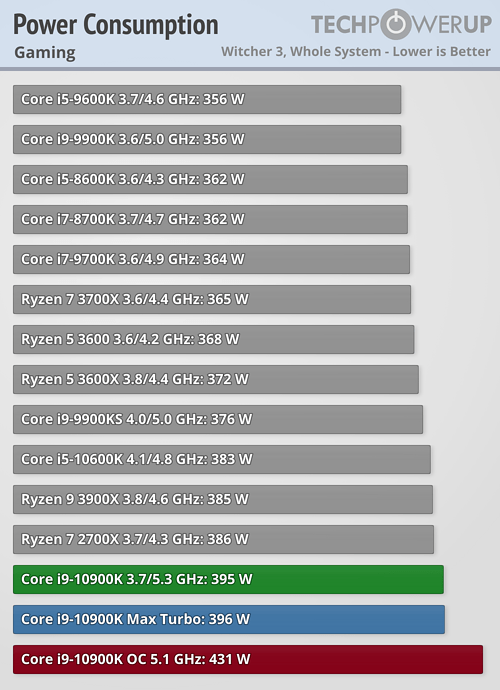So what will RL bring over current gens? I can't think of a single thing really.
- Productivity is surrendered to the higher core count Ryzens, so that's out of the window.
- Gaming will be a smidge better, again, very hard to spot and feel a difference especially when gaming at higher than HD levels where you're most likely to be GPU bound anyway.
- 250W vampire TDP sucking hog - good luck benching and overclocking on smaller PSU's.
- As mentioned above, a PSU upgrade might also be in order. More money down the drain.
- Hot as hell, good luck gaming with a machine so loud next to you that has to be super tuned to contain noise levels.
- Half the lineup consists of non K (locked) models. If AMD can offer full gens of OC'able chips (with hardly any exceptions), why can't Intel do the same?
- No 12C or 16C options. Forget upgradable options down in the future.
- PCIE4 coming like 2 years late? Or shall I say well done?
- Backported product. Knowing that your product's full potential won't be realized.
- Regressing on core count. And they wanna call their highest boosting chips "i9's" to differentiate from the slightly lower clocked i7's?
- Do you also get Farcry6 free with RL as you do with new Ryzen? Or anything else seeing that Intel has promoted it as a "gaming" chip?
I can go on and on, but my brain has finally put up the white flag. Pat should have joined 5+ years ago.
I would be a lot more thrilled about the Ryzen 5000 series if AMD actually had supply readily available, and if they hadn't jacked up the prices, with still no value models anywhere in sight.
You mention Intel cutting the core count for their i9s, but AMD did something similar, in that they significantly raised the minimum prices for a given core count. The only Zen3 6-core is currently priced at $300, whereas the 3600 was just $200 when it launched, with the street price being more like $160 to $170 throughout much of last year. Even just looking at the MSRPs, that's a 50% price hike, which kills a lot of the enthusiasm for the performance gains. The same goes for the 8-core model priced at $450, a $120 price hike over the previous gen's launch MSRP. Six cores now cost nearly as much as the prior-gen's 8-cores did at launch, and 8-cores cost nearly as much as the prior-gen's 12-cores, negating any performance gains in heavily-multithreaded workloads.
And despite increasing prices, they also cut the stock coolers. The 5600X is the only model that includes one now, and despite being a $300 processor, it's not the Wraith Spire or the Prism, but rather the tiny Stealth that they previously only put on sub-$200 parts, and which doesn't perform much better than Intel's stock coolers. Including a Prism might have made the price point a bit more justifiable, and they probably should have bundled one with the 5800X as well, considering the significantly higher profit margins of these processors.
The 12 and 16-core models only saw a $50 price hike as far as MSRPs go, which is a lot more reasonable given their price points, but they are rather pricey processors to begin with, and relatively few people will actually have much need those kinds of core counts any time soon.
And due to AMD not having enough 7nm manufacturing capacity at TSMC to handle the combined production of their CPUs, GPUs and console APUs, it's hard to find any of these processors in-stock, outside of places selling them for well above those already high MSRPs, even three months after launch.
As for Intel's competing unlocked models, the MSRP of the 10-core 10900KF is only around $20 more than AMD's 8-core 5800X, the 8-core 10700KF is $100 less than the 5800X, and the 6-core 10600KF is over $60 less than the 5600X. And even the locked models are worth comparing, since the current 5000-series lineup is already pushed to its limits, offering very little overclocking headroom, making that more of a non-feature. Sure, AMD's SMT implementation tends to get more performance out of heavily-multithreaded workloads, but due to the high pricing, they aren't really offering better value than Intel's parts. AMD is currently providing Intel-like performance, at Intel-like prices, and for some parts Intel has them beat from a price to performance standpoint. And while the Intel parts might have other drawbacks like their higher power draw and heat output, at least they are readily available for purchase, typically at or below MSRP.
I was kind of hoping AMD might announce more value-oriented options at CES, but that didn't happen, and current rumors seem to suggest those won't be coming for a number of months still, likely not until sometime after Rocket Lake. Of course, it's not like it's all that practical to build a performance-oriented system now anyway, due to the graphics card shortages.




